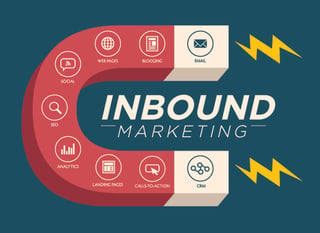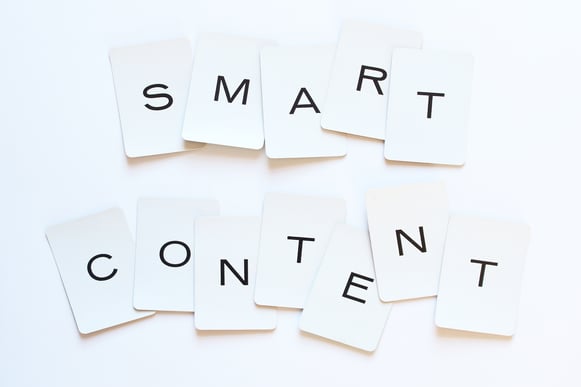Want to integrate creative marketing ideas into your inbound strategy, but aren’t sure how? HubSpot has the perfect course for you. HubSpot has an inbound marketing course that covers all the bases of inbound from social to analytics to sales.
Having recently completed this course, I recommend it to anyone wanting to learn how to market their business effectively. Going through each lesson, I learned about the fundamentals of inbound marketing, the role each fundamental piece plays, and how to use these elements to create a successful content strategy to align with your larger inbound marketing goals. These fundamentals can help you transform your creative marketing ideas into actionable marketing tactics.

The Five Fundamentals of Inbound Marketing
The five most important things you should always have in mind when creating your inbound marketing and content strategies are:
1. Contacts
Contacts are the most important tool you have in your inbound toolbox, and they are the heart of your inbound marketing strategy. These are the people you’re providing value to, and in return they help you grow your business. Contacts are not just numbers and data, they are people you should be building and fostering relationships with in order to provide them with an effective service or product. By creating these relationships you can better understand who you are marketing to and how to adjust your strategy based on consumer data. The more information you gather, the easier it will be for your marketing team to identify which contacts your business is successfully helping and satisfying.
2. Buyer PersonasBuyer personas are semi fictional representations of your ideal customers based on data such as demographics, geographics, psychographics, and sociographics. This data is pulled from contacts and individuals who are already buying from you. This allows you to step into the mind of your consumers and see your company from their point of view. Buyer personas help you better understand what your potential consumers want to see in order to create more strategic, valuable content.
3. Buyer’s JourneyEvery interaction your persona has with your organization should be tailored to where they are in their buyer's journey. The buyer's journey is the active process an individual goes through to research the organization, product, or service leading up to the initial purchase. Being knowledgeable about the buyer's journey will enable you to create effective content directed at different personas in different stages of their journey. The stages of the buyer's journey include the awareness stage, consideration stage, and decision stage — all of which your potential customers go through before making a purchase.

Once you understand your buyer personas and their journey, you can finally start your inbound marketing strategy! This is where the fun begins and where all your creative marketing ideas can finally come to fruition. Creating content that is relatable and creative is key to inbound marketing. Content can be anything your organization creates, including social media posts, blog posts, videos, ebooks, and advertisements.
Context is important to understand as well. Who are you creating content for? This is where buyer personas and journeys are incorporated into the creation of marketing materials. All inbound materials should be tailored to the audience you are trying to reach and their interests. Content needs to be grounded in the right context in order to be effective.
5. Goals
Setting goals allows you and your team to see if your inbound marketing efforts are successful. Without goals, your organization will have nowhere to go and no way to measure if you’ve made it there. By goal setting, you pave a pathway for growth in your organization.
In order to measure your success your goals need to be SMART. Specific. Measurable. Achievable. Relevant. Time-Bound. Using these constraints while goal setting will help you better analyze and understand your success and adjust your inbound marketing strategy accordingly.
These five fundamentals are vital to building a successful inbound strategy and creating a foundation for you to implement your creative marketing ideas. Your inbound strategy should include each fundamental component and should ALWAYS relate back to your content. That’s how you effectively reach your target audience and gain traffic on social media accounts, your blog, and your website.
Inbound Marketing and Content Marketing
Content marketing is an element of inbound marketing, and they both have very similar objectives:
- Empowering potential customers
- Building relationships with customers
- Creating content that entertains and educates
Success relies on both content marketing and inbound marketing, and the two are very interrelated. You can’t have a successful inbound marketing strategy without content. And you won’t see successful interaction with your content strategy without good inbound practices!
Building Your Content Strategy
Content is the most important component of your inbound marketing. It’s how you deliver valuable information about your products, services, and business to use in your inbound marketing strategy. Content is the string that’s pulling your leads through their buyer’s journey, and it’s a cornerstone of inbound marketing — from attracting to engaging to delighting your customers.
Content is all about your audience — what they’re looking for, what they value, and how you can help educate them. Content helps you build your relationship and trust with your audience. Once your audience has a better understanding of your organization (who you are and what you offer them), they are more willing to do business with you and trust that you’re the right solution to their problem.
And content development shouldn’t stop after gaining customers. Your next goal is to turn your customers into promoters of your brand. You want to keep prospects and customers engaged, fostering your relationship with them without any smarmy sales tactics.
Creating Your Content Plan
Content planning is everything. It not only helps keep you organized, but it can help you flesh out the different stages of the buyer's journey we discussed earlier. It’s also where your creative marketing ideas can be fleshed out into real assets you’ll use in your inbound strategy.

When creating a long term content plan you should walk through these three steps:
- Setting Marketing Goals
Setting marketing goals allows you to have a long-term and short-term vision for what your marketing strategy will look like. Content you create should always relate back to an overarching goal. Using the SMART goals outline we discussed earlier is a perfect format for creating your marketing goals.
- Assessing your Organization's Assets
Performing a content audit and event-based audit will help you assess current assets and initiatives your organization already possesses. A content audit will consist of all marketing assets at your disposal, and it can highlight potential gaps you need to fill in your content strategy. An event-based audit focuses on any important projects, priorities, or events that may involve content creation to communicate with consumers and connect them back to the buyer's journey through an inbound marketing campaign.
- Identifying the Buyer's Journey for your Personas
You should be creating content that attracts and pulls your leads through every stage of the buyer's journey. Your buyer personas give you the bumpers to speak to your target audience authentically and effectively. Identifying this content early on can give you ideas for future content, inbound campaigns, and other creative marketing ideas.
Ensuring that your content strategy is as robust as your inbound marketing strategy will enable your organization to communicate with buyer personas, stand out from competitors, and nurture relationships with current and future customers.
Wow, we’ve covered a lot here! Creating a robust inbound marketing strategy that incorporates your creative marketing ideas is a hefty task. But once you start implementing inbound practices into your organization’s marketing efforts, you’ll see big results. And your future campaigns will be even easier to create.
You can continue your inbound education with an Inbound Methodology course from HubSpot or check out another HIVE blog post to see what the costs of inbound marketing might look like for your business.

.png)


.png?width=100&height=100&name=Why%20Were%20Not%20a%20Marketing%20Agency%20(And%20What%20That%20Means%20for%20Your%20Growth).png)
